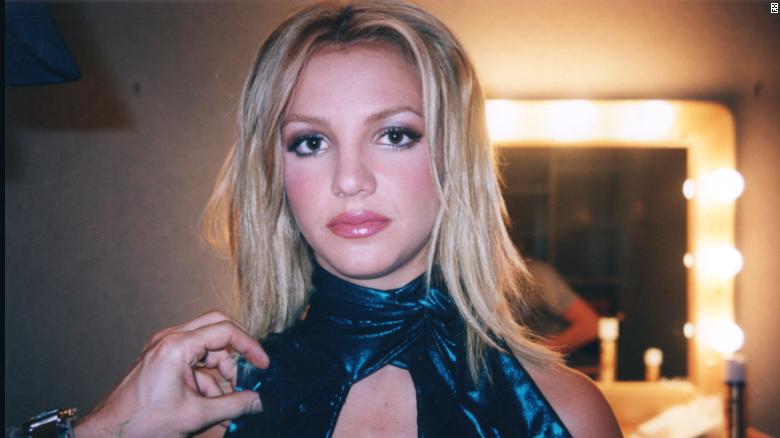
There’s a moment in the new The New York Times Presents documentary, Framing Britney Spears, that anyone who has at least tangentially followed Spears’ career is familiar with—but the documentary recontextualized it for me in an instructive way.
In it, Britney, a 10-year-old vocal powerhouse in a frilly black dress with a giant bow, has just finished a performance on Star Search. Host Ed McMahon is doing a post-performance interview with her and her competitor.
“I noticed last week, you have the most adorable, pretty eyes ,” he says to Britney. “Do you have a boyfriend?”
“No,” she says, embarrassed, and slightly taken aback.
“Why not?”
“Because they’re mean.” (You go, girl.)
The first time I saw this clip, I thought it was innocuous—an avuncular exchange between a friendly old man and a child.
Now, of course, I see it in a different light. Why the hell was McMahon asking a 10-year-old girl about boys? Why wasn’t she asked about her singing? Her aspirations? Her favorite subject in school? Why was her entire performance boiled down to how pretty she was and her allure—or future allure, as he was clearly suggesting—to the opposite sex? And more importantly, why the hell wasn’t I appalled the first time I saw this?
(The documentary doesn’t show it, but I looked up the clip on YouTube. Britney’s pint-sized cowboy competitor is interviewed next: “So you grew up on a farm,” McMahon says to him. “What was that like?”)
I’ve been writing and thinking about sexism and misogyny since I started my career as a critic, but if there’s one thing this upsetting and enlightening documentary reveals, it’s that a kind of casual sexism has been so baked into our coverage of female celebrities, we sometimes don’t even notice it.
Of course, Britney was the victim of much worse as her career went on, leading us to where we are today.
The documentary is largely about the #FreeBritney movement, which was started by a group of dedicated Britney Spears fans who believe that the court-ordered conservatorship she is under is a violation of her rights. They picket, they protest, they generate trending hashtags—and their ranks will no doubt swell after this documentary.
How did it come to this? The doc takes us back—to her rise to fame, from a normal kid in Louisiana to a Mouseketeer to a nearly overnight pop sensation. “(Hit Me) Baby One More Time” was, in many ways, the perfect first single and video for the would-be pop icon. Britney, dressed in that now famous school girl’s uniform, in pigtails, her blouse knotted at the waist to reveal her torso, found that sweet spot between naughty and innocent, between woman and girl.
Much is made in the documentary about how Britney had more agency over her own career than we realize—and I believe it—but this first video was clearly conceived of by men, meant to titillate boys and be aspirational to girls, meant to launch a million fantasies while also being winkingly controversial (I mean, those lyrics!). No matter what the video’s intentions, Britney’s gaze into the camera is so confident, her charm and talent so evident, you can’t help but to be entranced.
From there, her career sky-rocketed and she became the most famous pop singer in the world. But the duality established in the first video—and the conflicting feelings it evoked—would haunt her.
Journalists, often men, but not always (I see you, Diane Sawyer) were constantly asking about sexuality. Was she a virgin? Was she a bad role model? Why did she dress that way? One British interviewer asked her about her breasts and if she would consider implants. (She was 17.) Our very own former first lady Kendel Ehrlich famously said, “You know, really, if I had an opportunity to shoot Britney Spears, I think I would.” (She has since apologized.)
She was hounded, mercilessly, by the tabloids. At first, she liked it—of course she would. She was a kid. It was novel and fun. Later, she hated it, as the paparazzi throngs became larger, more probing, more dangerous. One paparazzi interviewed in the documentary—it would later be revealed that he was the one who took the notorious picture of a newly bald Britney attacking his car with an umbrella—seemed to resent her rejection, like a spurned boyfriend: She used to like us, she’s the one who changed—it’s her fault we hurt her. (His utter lack of remorse reminds me of that old actor’s adage, “We are all the heroes of our own lives.”)
Then along comes Justin Timberlake, the pop star who would become her boyfriend, and this is arguably the most telling part of the documentary. For a while, they were the golden couple, loved by everyone. But when they broke up, the tabloids took his side, naturally. (I’ve noticed that tabloids almost always blame the female when a celebrity couple breaks up, especially if she is perceived as being sexual—see Angelina Jolie and Brad Pitt, or, more recently, Olivia Wilde and Jason Sudeikis.)
While Britney was still forced to defend her virginity, Timberlake went on the Howard Stern Show and boasted that he’d had sex with the pop princess. A Details magazine cover praised Timberlake for “[getting] in Britney’s pants.” A year later, Timberlake would be involved in the Janet Jackson Super Bowl controversy—once again emerging unscathed while a female celebrity was shamed and shunned. It’s not inaccurate to say that his career has benefited greatly from our culture’s maddening double standard when it comes to male and female sexuality.
After the Timberlake breakup things began to unravel for Britney. She began partying with the likes of Paris Hilton and Lindsay Lohan (each likely worthy of their own similar documentary about how they were wronged by the press). She got under the thumb of an apparent opportunist, Larry Rudolph, who became her manager and took control of her life. She met bad boy Kevin Federline, married him, and they had two sons. After she and Federline split, there was a highly publicized custody battle, accusations that she was a terrible mother, rumors of drug use. The head-shaving incident. The umbrella. Stints in rehab.
And never once did the paparazzi or the media pause, reflect, and consider their own role in her downward spiral. Instead, they feasted at the buffet of her self-destruction. (Kudos, however, to Craig Ferguson. A recently unearthed clip shows the former late night host refusing to make fun of Britney’s woes and castigating himself for his previous role in mocking the likes of Anna Nicole Smith.)
I can’t help but to remember the wonderful documentary about Amy Winehouse, Amy. A similar pattern emerged—she was (literally) propped up by hangers-on and those who served to profit off of her (including her father) and mocked by the press for her downfall. She died of a drug overdose at the age of 27.
Today, Britney Spears is 39 years old. The court has ordered that she—and more importantly, her estate—be under the control of her father, Jamie Spears. According to the doc, he was an inconsistent figure in her childhood. (He is a recovering alcoholic, who once also filed bankruptcy.) The doc indicates that Britney is willing to be under conservatorship—she just wants someone other than her father. Seems reasonable. Various judges and lawyers (mostly men) seem to disagree.
Look, no one really knows what’s going on with Britney, but the whole thing is quite shady, to say the least. While under conservatorship, she somehow managed to do that sold-out Vegas residency. So you’re telling me that a woman capable of a Vegas show can’t control her own life? (Tellingly, she stepped away from the residency, by her own volition.) Is the concern for her welfare or the welfare of her millions—money that, no doubt, to this day makes many people very, very rich. Again, we don’t know the answers to this, but the documentary certainly raises many provocative questions.
And here’s the thing about Britney: Her fans (I consider myself one) have a devotion to her that is singular. There’s something about having watched her grow up right in front of us—we watched her go from sweet country girl to international sensation to troubled adult—that makes us protective of her. We have an emotional attachment to her, rarely achieved with other celebrities. We just want her to be happy, healthy, and free. Is that too much to ask?
The New York Times Presents: Framing Britney Spears is now streaming on Hulu.
